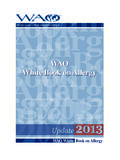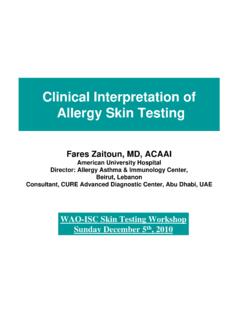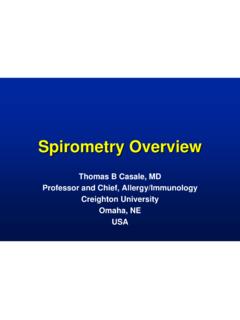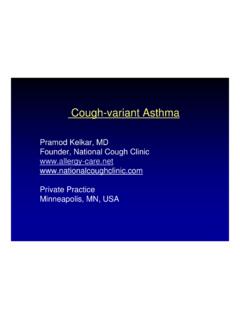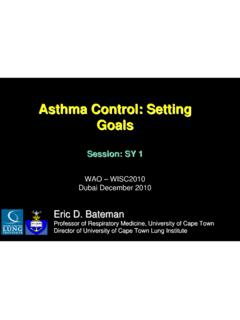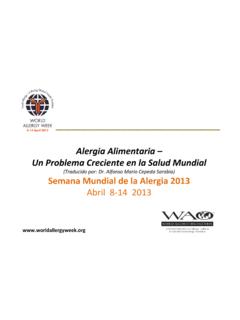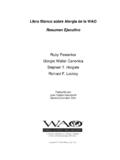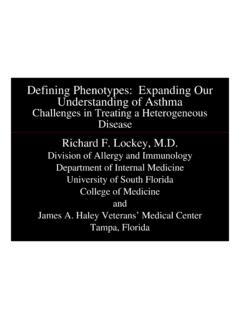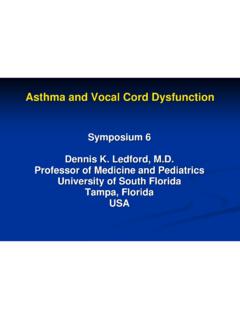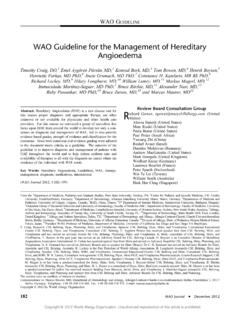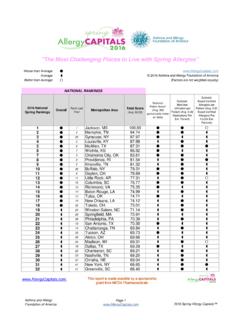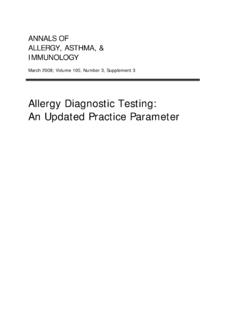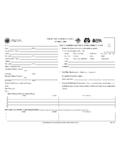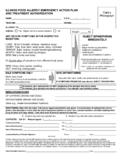Transcription of WAO White Book on Allergy - World Allergy Organization
1 World Allergy ORGANIZATIONWAO White book on AllergyWAO White book on Allergy WAO White book on Allergy World Allergy Organization (WAO) White book on AllergyCopyright 2011 World Allergy OrganizationEditorsAcknowledgementProf. Ruby Pawankar, MD, PhDWAO President Elect (2010-2011) Allergy and Rhinology Nippon Medical School 1-1-5 Sendagi, Bunkyo-ku Tokyo 113-8603 JAPANProf. Stephen T. Holgate, BSc, MD, DSc, FMed SciMember, WAO Board of Directors (2010-2011) Medical Research Council Clinical Professor of Immunopharmacology Infection, Inflammation and Immunity School of Medicine University of Southampton Level F, South Block Southampton General Hospital Tremona Road Southampton SO16 6YD United KingdomProf. Giorgio Walter Canonica, MDWAO Past President (2010-2011) Allergy & Respiratory Diseases Department of Internal Medicine University of Genoa Padiglione Maragliano, Largo Rosanna Benzi 10 1-16132 Genoa ITALYProf. Richard F. Lockey, MDWAO President (2010-2011) Division of Allergy & Immunology Joy McCann Culverhouse Chair in Allergy & Immunology University of South Florida College of Medicine James Haley Veterans Administration Medical Center (111D) 13000 Bruce B.
2 Downs Boulevard Tampa, Florida 33612 USAOn behalf of the World Allergy Organization (WAO), the editors and authors of the WAO White book on Allergy express their gratitude to the charity, Asthma, Allergy , Inflammation Research (AAIR) and Asian Allergy Asthma Foundation (AAAF) for their support in the production of this Editors of the White book extend their gratitude to His Excellency Dr. APJ Abdul Kalam, Former President of India and Madame Ilora Finlay Baronness of the House of Lords for their Forewords to the White book and to the International Primary Care Respiratory Group (IPCRG) and European Federation of Allergy and Airways Diseases Patients Associations (EFA) for their supporting statements. The editors also wish to thank the many experts around the World who have contributed to the completion of this book . Both the editors and authors also thank WAO staff members, Charu Malik and Karen Henley, for their editorial assistance, and Sofia Dorsano, for her technical assistance, in preparing the White 0615461824 ISBN-13 9780615461823 Copyright 2011 World Allergy Organization (WAO).
3 All rights reserved. No part of this publication may be reproduced in any form without the written consent of the World Allergy Organization . This book is not for Allergy Organization555 East Wells StreetSuite 1100 Milwaukee, Wisconsin 53202 United States of AmericaPhone: +1 414 276 1791 Fax: +1 414 276 3349 Email: : Printed in the United Kingdom, 2011 WAO White book on Allergy World Allergy Organization (WAO) White book on AllergyEditorsRuby Pawankar Giorgio Walter Canonica Stephen T. Holgate Richard F. LockeyCopyright 2011 World Allergy OrganizationWAO White book on Allergy1 Copyright 2011 World Allergy OrganizationAllergic diseases are increasing worldwide with unprecedented complexity and severity. Children bear the greatest burden of allergic deseases. The most common allergic conditions in children are food allergies, eczema, and asthma. The precise causes of this increase in allergic diseases are not fully understood but as the numbers of afflicted people increase, so does the research and development, and progress is being should be recognized as a public health problem and efforts should be made towards its prevention and optimal treatment.
4 To achieve this, public awareness should be increased and efforts should be made towards proper education and training for more integrated and holistic approach to the diagnosis and management of allergic White book on Allergy is an important initiative by the World Allergy Organization calling on international and national health care policy makers to address early identification of symptoms, early diagnosis and appropriate strategies to manage and control allergies to avoid worsening of severe allergic disease to people at risk and to improve practice in this clinical field of medicine for the benefit of those suffering from the consequences of allergies. I congratulate the World Allergy Organization for initiating this timely and much needed document and wish them all success in its impact and Dr. APJ Abdul Kalam Former, President of India New Delhi, IndiaForeword by His Excellency Dr.
5 APJ Abdul Kalam, Former President of IndiaWAO White book on Allergy3 Copyright 2011 World Allergy OrganizationI am delighted to have an opportunity of adding my strongest support to the principles laid out in this World Allergy Organization White book on Allergy . Indeed, many of the recommendations align with those of a recent report on Allergy Services that I was asked to chair in 2006 for the UK House of Lords Committee on Science Technology ( ). The scope of the Report encompassed an assessment of recent trends of Allergy prevalence, the social and economic burdens that allergic disorders cause, current Allergy treatments and research strategies, and policies which impact upon Allergy patients such as housing standards, food labelling and the work and school environments. As with the White book , our report came at a time when the prevalence of allergic disorders in this country has been claimed to have reached epidemic proportions.
6 Although it is unlikely that a cure for all forms of Allergy will be found in the near future, we have made a number of recommendations which we believe will contribute to the prevention, treatment and management of allergic disorders. Our main conclusions and recommendations were:1) There is a need for Allergy centres where specialist, high quality diagnostic and treatment services that are accessible to the public. Once a diagnosis is obtained and a treatment plan developed at the Allergy centre, the patient s disease can often be managed back in primary or general secondary care. However, patients with severe or complex allergic conditions may need long-term follow-up from specialists in the Allergy immunotherapy by injection should always be carried out by specialists within the Allergy centre because of the risk of anaphylaxis. Collaboration between clinicians in primary, secondary and tertiary care is key to improving the diagnosis and management of people with allergic conditions.
7 Once established, the Allergy centre in each geographical region should encourage and co-ordinate the training of local GPs and other healthcare workers in Allergy . In a hub and spokes model, the Allergy centre, or hub, would act as a central point of expertise with outreach clinical services, education and training provided to doctors and nurses in primary and secondary care, the spokes. In this way, knowledge regarding the diagnosis and management of allergic conditions would be disseminated throughout the Allergy centre should also act as a lead in providing public information and advice. Specialists at the centre should work in collaboration with Allergy charities, schools and local businesses to provide education and training courses for Allergy patients; their families; school staff and employers; in how to prevent and treat allergic ) Because of the lack of knowledge of health professionals in the diagnosis and treatment of allergic diseases, we recommended that those responsible for medical training strengthen the input of clinical Allergy to the undergraduate and postgraduate training of internists and primary care physicians as well of those of ) Although high quality research into cellular and molecular mechanisms of Allergy is advancing, the factors contributing to Allergy development and the Allergy epidemic, are poorly understood.
8 It is imperative that further research should focus on the environmental factors, such as early allergen exposure, which may contribute to the inception, prevention or exacerbation of allergic disorders. We were concerned that the knowledge gained from cellular and molecular research in Allergy was not being translated into clinical practice and was identified as an area of unmet need that required greater priority. Immunotherapy is a valuable resource in the prophylactic treatment of patients with life-threatening allergies, or whose allergic disease does not respond to other medication. Although initially expensive, immunotherapy can prevent a symptomatic allergic response for many years, and may prevent the development of additional allergic conditions, so its wider use could potentially result in significant long-term savings for health services. Full cost-benefit analyses of the potential health, social and economic value of immunotherapy treatment needs to be conducted so the case for its use and funding can be strengthened.
9 4) We recognised the appreciable impact that allergic rhinitis has on student performance in schools and examinations. Indeed, we wished to encourage health professionals to interface more closely with schools to ensure children with allergic disease receive optimal care. We support the use of individual care plans for children with medical needs. However, we were concerned that many teachers and support staff within schools are not appropriately educated in how to deal with allergic emergencies and should take urgent remedial action to improve this training where required. We were especially concerned about the lack of clear guidance regarding the use of autoinjectors of adrenaline on children with anaphylactic shock in the school by Baroness Finlay, House of Lords, United KingdomPawankar, Canonica, Holgate and Lockey4 Copyright 2011 World Allergy Organization5) We considered that controlled trials should be conducted involving multiple interventions to examine the effect of ventilation, humidity and mite-reduction strategies on Allergy development and control.
10 As climate change and air pollution may significantly impact upon the development of allergic disease, we supported greater effort to take account of the interlinkages between air quality, climate change and human ) Vague defensive warnings on food product labels for consumers with food Allergy can lead to dangerous confusion and an unnecessary restriction of choice. We recommend that the responsible government agencies should ensure the needs of food-allergic consumers are clearly recognised during any review of food labelling legislation. Many teenagers and young adults with food allergies sometimes take dangerously high risks when buying food. We considered that the relevant government agencies, charities and other stakeholders should explore novel ways to educate young people about Allergy and the prevention of anaphylaxis. As sensitivities to various allergens vary widely, the setting of standardised threshold levels for package labelling is potentially dangerous for consumers with allergies.
